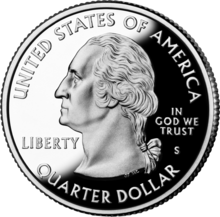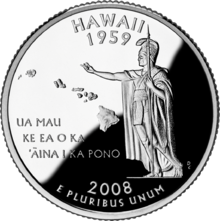
Back أرباع 50 ولاية Arabic Čtvrtdolar 50 amerických států Czech State Quarters German Cuartos de dólar de los 50 estados Spanish کوارترهای ۵۰ ایالت Persian Série des pièces américaines de 1/4 de dollar des 50 États French Cuartos de dólar dos 50 estados Galician 50 State Quarters Italian 50州25セント硬貨 Japanese 50주 쿼터 주화 Korean
United States | |
| Value | 0.25 US Dollar |
|---|---|
| Mass | 6.25 (Ag); 5.67 (Cu-Ni) g |
| Diameter | 24.26 mm (0.955 in) |
| Thickness | 1.75 mm (0.069 in) |
| Edge | 119 reeds |
| Composition | 91.67% Cu 8.33% Ni (standard) 90% Ag 10% Cu (proof only) |
| Years of minting | 1999–2008 |
| Mint marks | P, D, S (proof only) |
| Obverse | |
 | |
| Design | George Washington |
| Designer | John Flanagan (1932 version) from a 1786 bust by Houdon / William Cousins (modification to Flanagan's design) |
| Design date | 1999 |
| Reverse | |
 | |
| Design | various; five designs per year (latest shown) |
| Designer | various |
| Design date | 1999–2008 |
The 50 State quarters (authorized by Pub. L. 105–124 (text) (PDF), 111 Stat. 2534, enacted December 1, 1997) was a series of circulating commemorative quarters released by the United States Mint. Minted from 1999 through 2008, they featured unique designs for each of the 50 US states on the reverse.
The 50 State Quarters Program was started to support a new generation of coin collectors,[1][2] and it became the most successful numismatic program in US history, with roughly half of the US population collecting the coins, either in a casual manner or as a serious pursuit.[3] The US federal government so far has made additional profits of $3 billion from collectors taking the coins out of circulation.[4]
In 2009, the US Mint began issuing quarters under the 2009 District of Columbia and US Territories Program. The Territories Quarter Program was authorized by the passage of a newer legislative act, H.R. 2764. This program features the District of Columbia, Puerto Rico, American Samoa, Guam, the United States Virgin Islands, and the Northern Mariana Islands.[5]
- ^ Muoio, Anna. (1999-11-30) "Mint Condition" Archived May 25, 2017, at the Wayback Machine, Fast Company. Retrieved 2011-01-16.
- ^ David L. Ganz, The Official Guidebook to America's State Quarters, Random House, 2000.
- ^ Healey, Matthew (November 28, 2007). "State Quarters Near End of Popular Run". The New York Times. Archived from the original on December 23, 2013. Retrieved November 28, 2007.
- ^ "50 State Quarters Report: 10 Years of Honoring Our Nation's History and Heritage" (PDF). US Mint. Archived from the original (PDF) on March 10, 2016. Retrieved January 24, 2014.
- ^ Noles, Jim. A Pocketful of History: Four Hundred Years of America – One State Quarter at a Time (Boston: Da Capo Press, 2009).